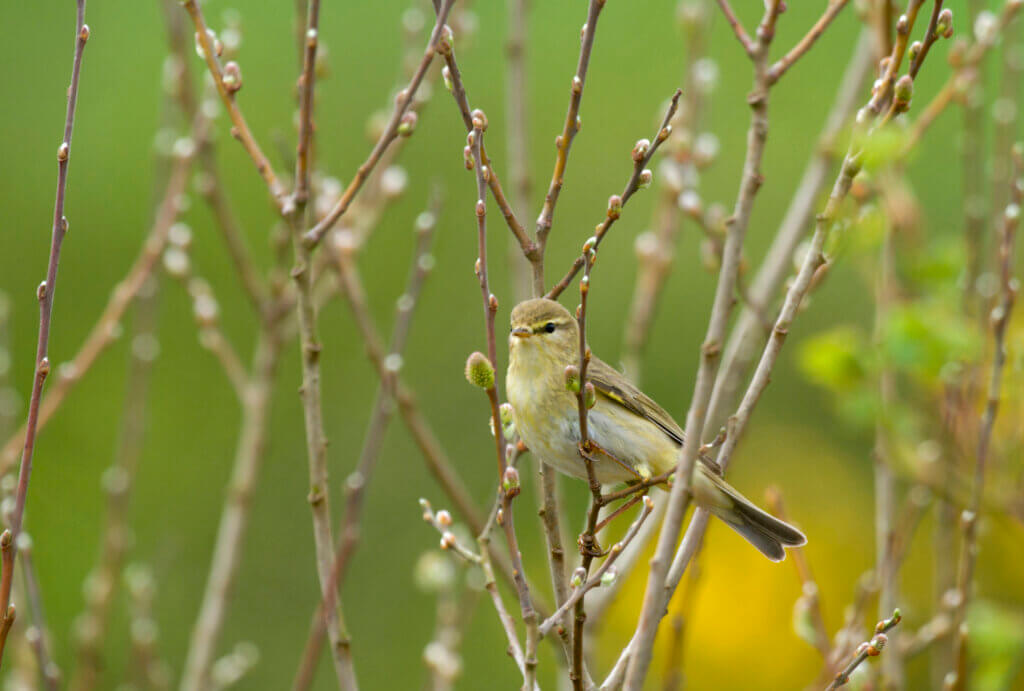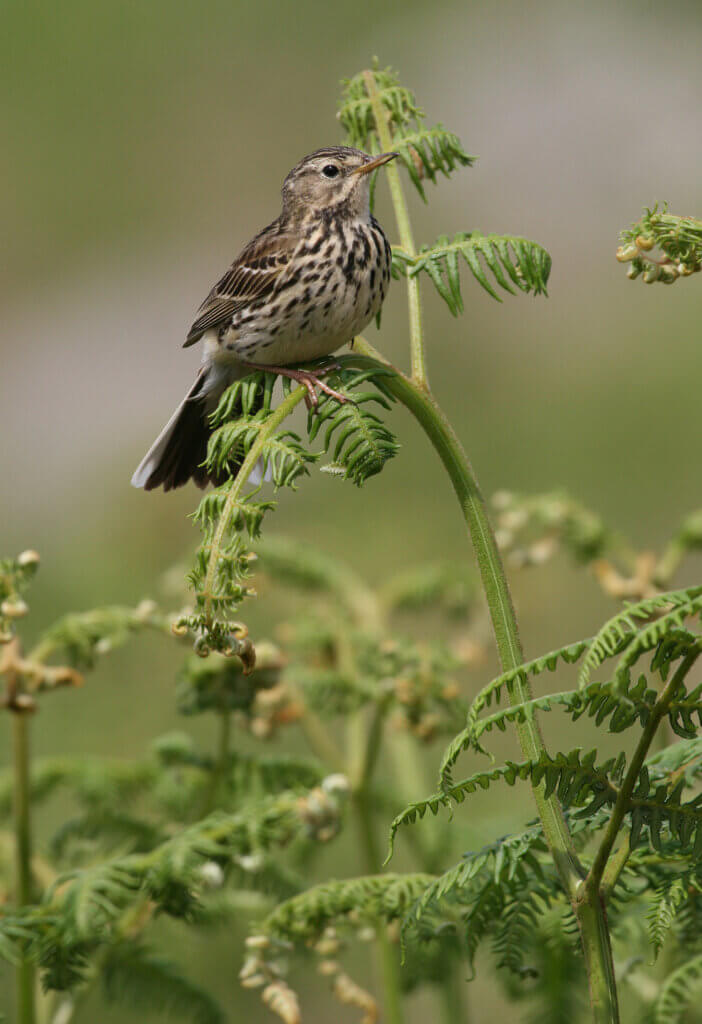NEW RESEARCH SHOWS OVERALL BENEFITS FOR BIRDS FROM RESTORING NATIVE WOODLAND BUT SOME MOORLAND SPECIES MAY LOSE OUT

RSPB research in Scotland suggests that native woodland plantations could have overall benefits for some breeding birds – but care should be taken not to squeeze out important species of open ground.
The study, published in the journal Biological Conservation, looked at the breeding bird communities in native woodland plantations and nearby open moorland in Highland Perthshire.
Overall, more bird species were present in native woodland plantations relative to moorland and the number of species increased with the age, height and cover of the woodland present.
Many songbird species were also more common in woodland than on moorland, but the Meadow Pipit, which favours open moorland, is expected to lose out through woodland creation. Meadow Pipits are of conservation concern due to population declines and are listed as globally Near-Threatened by the IUCN. The UK supports globally important breeding populations of the Meadow Pipit and some other open-ground species including the Eurasian Curlew, so impacts from woodland creation on these species should be minimised.

Researchers concluded “Native reforestation of open ground offers net gains in bird species richness but could disbenefit open-ground birds including those of conservation concern. Where retention of open-ground species is desired, landscape-scale reforestation should consider both woodland and open-ground wildlife.” This new research therefore emphasizes that serious thought must be given to how to minimize impacts on open-ground biodiversity of high conservation importance.
The Scottish Government has set ambitious targets to create 12,000 to 15,000 hectares of new woodland annually until 2032 and wishes to increase Scotland’s woodland cover to 21% of land area. This has the potential to deliver on climate change and biodiversity targets but a large proportion of this newly created woodland is comprised of non-native tree species.
RSPB Scotland’s Head of Land Use Policy Vicki Swales said: ‘Increasing the area of woodlands has a key part to play in helping Scotland’s wildlife as well as tackling climate change. Native woodlands can be a fantastic home for birds and many plants, insects and mammals. But this research shows that careful attention will have to be paid to what trees are planted and where; we need the right trees in the right places. For some of our most important birds maintaining open moorland and not planting trees there remains key.‘.
Dr David Douglas, lead author of the research said: ‘Creating native woodland on moorland should increase the overall number of bird species using these areas, but birds that are adapted to open ground are likely to lose out. We only studied native woodland but we know that in Scotland, a large amount of new woodland currently being created is commercial plantation forestry dominated by non-native species. We urgently need to understand where to place new woodland – whether native or non-native tree species – to minimise the impacts on important open ground biodiversity.‘.
Ends
[registration_form]
The one definite thing from this is that commercial plantations have essentially no conservation benefits. However, they’ll go to meet tree planting targets so another box ticked. It’s a shame Scotgov wasn’t better at delivering rather than window dressing with all its talk about the circular economy. That would mean considerably more emphasis on waste reduction, reuse and recycling so we’d be moving away from the linear model of resource extraction to processing to landfill/incineration which is not good for wildlife and ultimately people on a small planet.
Unfortunately if all current plans for new incinerators go ahead in Scotland we will be REQUIRED to produce two million tons of ‘waste’ per year for decades to keep them going, that will be out of total arisings in the business and domestic waste sector of five point five million tones per annum. So if you want to make money from the cheap plastic crap to be made from the the products of fracking or in commercial forestry you’ll be quids in. I’m struggling to see how this fits in with a circular economy TBH, it certainly won’t help with conserving resources or wildlife.
Like many Scottish local authorities my one is losing over a million pounds a year because the local population is not using the recycling scheme as well as it should. However, there is no money to pay for educational work to work with school children and get the participation rates up and make that a lifelong thing. According to the waste dept rep I spoke to, since promoted, the responsibility for that lies with the education dept though even though it’s absence is costing them a fortune. Sadly the conservation organisations are not demonstrating a better example of joined up thinking there is at present no focus to express concern at the disastrous plans for incineration in Scotland far less to coordinate action against them including making reduce, reuse, recycle work here. It seems getting a Climate Emergency declared is the cure for everything.
UK governments and others should also be reminded that we are essentially the only country in the world whose forestry industry relies almost entirely on non-natives. Surely that could and should be changed.
Firstly, we are by no means the only country in the world relying on non-natives – look up Pinus radiata – which dominate commercial forestry in New Zealand and Chile and probably several other countries – and comes solely from coastal California (where it is restricted & rare in its native range).
Secondly, it is staggering that anyone can still say that non-native plantations have no conservation value – conservation really does need to make the break into the 21stC. But if you are determined to stay in the 1990s I’d strongly reccomend Birds & Forestry, Bloomsbury, Avery & Leslie so you can at least be well informed.
Thirdly, something we did establish very firmly in the 1990s is that Greenshanks don’t live in trees: for species obsessionals, this research makes the very obvious point that the change from a 2D to 3D environment makes woodland quite unsuitable for open ground birds. Going beyond that, its not just point specific – we need to avoid fragmentation – open ground needs to be large scale and if you are going to fit in a lot of trees that means quite large forests.
However, the real answer is that the trees for timber/carbon should be further down the hill – on improved land, of which there is a great deal more than in 1990. In the open uplands we should perhaps be thinking of trees primarily as a returning component of a damaged landscape – as an example, I was very impressed by a recent account of RSPB Geltsdale in British Wildlife.
I’m fully prepared to be corrected, but to me forestry is like agriculture, the less intensive it is the better for wildlife, but then it takes up a larger area so you’re not really better off conservation wise there’s always a trade off and it’s never better than the natural woodland and other habitats it replaces. The best option is to need as little of it as possible. There will of a course be a very few species that do well even in the worst of the plantations, but I’m not sure that would have any real conservation value as it’s from a badly distorted ‘ecosystem’ rather than a healthy one.
I didn’t say that non natives have no conservation value but surely natives have better conservation value. I happily stand corrected on the forestry thing but would still prefer native or near native woodland including conifers than Sitka and Lodgepole. There are huge areas here in Wales of poor or reseeded grassland that have almost no wildlife value and the farmers are barely making a living that would be better either rewilded or planted with trees. There are also lots of conifer blocks here that are reaching maturity and NRW are replacing many of them with native woodland.
‘Secondly, it is staggering that anyone can still say that non-native plantations have no conservation value’
I think the question to ask is whether commercial non native plantations have greater conservation value than the habitat they replace.
My impression is that they don’t, and, given the commercial reality of what is planned, won’t in the future.
And whilst you would prefer trees to be planted further down the hill from my experience that doesn’t seem to be what is happening on the ground. It’s more like pushing the boundary further upwards and outwards and filling in gaps where they exist.
“RSPB research in Scotland suggests that native woodland plantations could have overall benefits for some breeding birds – but care should be taken not to squeeze out important species of open ground”.
I don’t mean to appear churlish, but I am somewhat mistified in what way this can be construed as a new finding. It may be ‘new research’ but I fail to see what knowledge it has added to what was already known.
I looked up the article, but could only read the Abstract as it is not published in a free to view journal.
That was rather my reaction too, and there’s a likelihood that it will be misused by the shooting lobby. Given that we need more trees but that blanket bog is better for carbon sequestration than trees, we need better planning than seemingly we have now. If that means more directive regulation, so be it.
I agree with Andy, not a lot new ,maybe a little clarification on a few points, common sense really.
How many birds of conservation concern are necessary to prevent
planting of trees in an area?, the odd pair of Curlew, or Golden Plover, here or there soon add up, for a few more Wrens or Coal tits.
The sterling efforts, of the Cairngorms Connect partnership, and others in the Central Highlands, are bearing fruit in that rich landscape, and will continue to do so for many years.
However, large scale restoration of native Woodlands,should also be taking place on the wet ,steep, impoverished green hills of the West,
where any wader egg laid would be liable to roll out of the nest before
it hatched.
I read someting yesterday to the effect that ~13 million trees had been cleared (just in Scotland iirc) in order to install wind turbines. Will the current mania for tree-planting start counting at -13,000,000 or 1?
Each windmill is embedded in a massive rodent-proof reinforced concrete plinth, so the area required for tree-planting merely to offset the trees lost to these unreliables will have to be found elsewhere.
No-one seems to have calculated the number of beavers required to attenuate the run-off flow from these monstrous carbuncles. It really is appalling.
Filbert – you aren’t Prince Charles in disguise are you?
No – I have never worn a sporran. Or even a kilt.
Wind farms and their carbon footprint !!!. – To say nothing of the millions and million tonnes of concrete, steel, limestone, tarmac, roads, wiring channels, ancillary bulidings etc which have been created to support construction, maintenance and output. The carbon footprint will take decades to recover. Many of these ‘farms’ have been allowed on moorland – even deep peat habitats. Hypercritical practice on the part of all and particularly planning authorities across the uk (including some who profess to be conservation bodies )!.